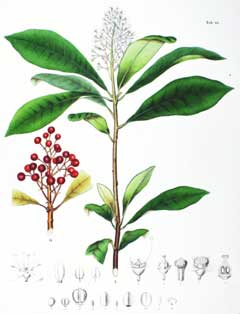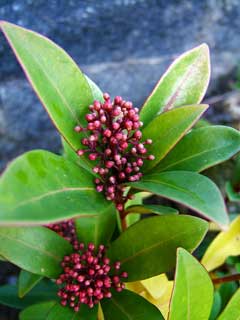 |
|
http://commons.wikimedia.org/wiki/File:Skimmia_japonica_SZ68.png |
 |
| http://commons.wikimedia.org/wiki/User:Wildfeuer |
Translate this page:
Summary
Bloom Color: White. Main Bloom Time: Early spring, Late spring, Mid spring. Form: Rounded, Vase.
Physical Characteristics

 Skimmia japonica is an evergreen Shrub growing to 2 m (6ft) by 2 m (6ft) at a slow rate.
Skimmia japonica is an evergreen Shrub growing to 2 m (6ft) by 2 m (6ft) at a slow rate.
See above for USDA hardiness. It is hardy to UK zone 7. It is in leaf all year, in flower from April to May, and the seeds ripen from October to December. The species is dioecious (individual flowers are either male or female, but only one sex is to be found on any one plant so both male and female plants must be grown if seed is required). . The plant is not self-fertile.
Suitable for: light (sandy), medium (loamy) and heavy (clay) soils and prefers well-drained soil. Suitable pH: mildly acid, neutral and basic (mildly alkaline) soils. It can grow in full shade (deep woodland) semi-shade (light woodland) or no shade. It prefers moist soil. It can tolerate atmospheric pollution.
UK Hardiness Map
US Hardiness Map
Synonyms
S. fragrantissima. S. oblata.
Plant Habitats
Woodland Garden Dappled Shade; Shady Edge; not Deep Shade; Ground Cover;
Edible Uses
References More on Edible Uses
Medicinal Uses
Plants For A Future can not take any responsibility for any adverse effects from the use of plants. Always seek advice from a professional before using a plant medicinally.
Carminative Restorative Tonic
The poisonous stems are carminative, restorative and tonic[178, 218].
References More on Medicinal Uses
The Bookshop: Edible Plant Books
Our Latest books on Perennial Plants For Food Forests and Permaculture Gardens in paperback or digital formats.

Edible Tropical Plants
Food Forest Plants for Hotter Conditions: 250+ Plants For Tropical Food Forests & Permaculture Gardens.
More

Edible Temperate Plants
Plants for Your Food Forest: 500 Plants for Temperate Food Forests & Permaculture Gardens.
More

More Books
PFAF have eight books available in paperback and digital formats. Browse the shop for more information.
Shop Now
Other Uses
References More on Other Uses
Cultivation details
Landscape Uses:Border, Container, Foundation, Pest tolerant, Massing, Woodland garden. Succeeds in a well-drained open loam or in a peaty soil[11, 200] preferring a rich slightly acid soil[184]. Thrives in moderately shady positions[11, 200] but also succeeds in full sun where the leaves may be rather yellow but the plant will flower and fruit better[200]. Plants are very tolerant of atmospheric pollution[184], being unharmed by deposits of soot or a sulphur-laden atmosphere[245]. Plants are hardy to about -15°c[184]. Often cultivated in the ornamental garden, there are many named varieties. The flowers have a sweet perfume[245]. Those of male forms are more aromatic than females[1], whilst the variety 'Fragrans' has a stronger scent like lily of the valley[245]. The bruised leaves are pleasantly aromatic[245]. The fruit is seldom eaten by birds, usually hanging on the plant until it flowers the following year[182]. A polymorphic species, it is usually dioecious but some forms are hermaphrodite, especially in ssp. reevesiana. (Fortune.)N.P.Taylor.&Airey Shaw[200]. This sub-species is intolerant of chalky soils[182] and is also much taller than the type. Another report says that it is smaller and weaker-growing than the type species[188]. Special Features:Not North American native, Fragrant flowers, Attractive flowers or blooms.
References Carbon Farming Information and Carbon Sequestration Information
Temperature Converter
Type a value in the Celsius field to convert the value to Fahrenheit:
Fahrenheit:
The PFAF Bookshop
Plants For A Future have a number of books available in paperback and digital form. Book titles include Edible Plants, Edible Perennials, Edible Trees,Edible Shrubs, Woodland Gardening, and Temperate Food Forest Plants. Our new book is Food Forest Plants For Hotter Conditions (Tropical and Sub-Tropical).
Shop Now
Plant Propagation
Seed - can be sown as soon as it is ripe in a cold frame[K]. It also succeeds when sown in early spring. When they are large enough to handle, prick the seedlings out into individual pots and grow them on in a shady position in the cold frame for at least their first winter. Plant them out into their permanent positions in late spring or early summer, after the last expected frosts. If there is sufficient seed then it can be sown can be in an outdoor seedbed in early spring[200]. Grow the plants on in the seedbed for a couple of years before planting them out in late autumn or early spring. Cuttings of half-ripe wood, July/August in a cold frame[11]. Cuttings of nearly mature side shoots, 7 - 10cm with a heel, September in a cold frame. Slow to root, they should be left for 18 months before moving to their permanent positions. Good percentage[78]. Layering in autumn. Takes 18 months. Good to high percentage[78].
Other Names
If available other names are mentioned here
Native Plant Search
Search over 900 plants ideal for food forests and permaculture gardens. Filter to search native plants to your area. The plants selected are the plants in our book 'Plants For Your Food Forest: 500 Plants for Temperate Food Forests and Permaculture Gardens, as well as plants chosen for our forthcoming related books for Tropical/Hot Wet Climates and Mediterranean/Hot Dry Climates. Native Plant Search
Found In
Countries where the plant has been found are listed here if the information is available
Weed Potential
Right plant wrong place. We are currently updating this section.
Please note that a plant may be invasive in one area but may not in your area so it’s worth checking.
Conservation Status
IUCN Red List of Threatened Plants Status :

Growth: S = slow M = medium F = fast. Soil: L = light (sandy) M = medium H = heavy (clay). pH: A = acid N = neutral B = basic (alkaline). Shade: F = full shade S = semi-shade N = no shade. Moisture: D = dry M = Moist We = wet Wa = water.

Expert comment
Author
Thunb.
Botanical References
1158200
Links / References
For a list of references used on this page please go here
Readers comment
| Add a comment |
|
If you have important information about this plant that may help other users please add a comment or link below. Only comments or links that are felt to be directly relevant to a plant will be included. If you think a comment/link or information contained on this page is inaccurate or misleading we would welcome your feedback at [email protected]. If you have questions about a plant please use the Forum on this website as we do not have the resources to answer questions ourselves.
* Please note: the comments by website users are not necessarily those held by PFAF and may give misleading or inaccurate information.
To leave a comment please Register or login here All comments need to be approved so will not appear immediately.
|
Subject : Skimmia japonica
|
|
|
|